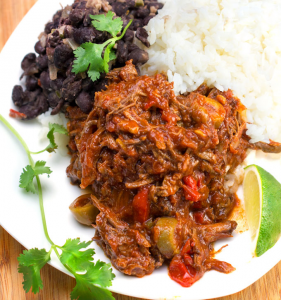Hola!
By Nora_Stone • December 13, 2018
What images come to mind when you think of Cuba? Perhaps a cherry red ‘55 Chevrolet Bel Air. Maybe the streets of Havana lined with neoclassical and baroque-style buildings painted chalky pinks and blues. Cuba is undeniably unique. The same can be said for its food. Despite economic hardship, communist bureaucracy, and embargoes, Cuba has retained a strong cultural identity. This identity is best seen in the cuisine of Cuba. Most meals consist of pork, chicken or beef served with rice, beans, yucca, or tamales. The flavors are savory and typically call for lots of garlic.
Cuban cooking is known for its richly seasoned meats. Ropa Vieja, a national dish, is beef braised in a savory sauce. It is usually prepared with wine, red peppers, tomatoes, cumin, and garlic. The meat shreds into tender strips that resemble wet clothes in the wash- thus, the name “old clothes” in English! This was a dish brought over by the Spanish during colonization in the fifteenth century. Like almost every Cuban meal, it is usually served with Arroz con Frijoles (rice and beans).

Cuban food is never fussy. It’s flavorful and simple. Tostones or fried plantains are popular dish that embody Cuba. Plantains are larger, darker versions of bananas. They grow well in the warm, tropical climate which made them important staples in the Special Time. This was a period during the reign of Fidel Castro when the USSR pulled its financial support from Cuba. This dominoed into a food shortage, rationing, and widespread hunger. Therefore, cooking meals with locally grown foods was a necessity. This is why Tostones are so central to the Cuban diet. To make them, the plantain is simply mashed into a patty shape, pan fried in oil, then lightly salted. It is a bit like hashbrowns.
Exploring the tastes of Cuba also means exploring its history. In a country about as large as Pennsylvania with only around 11 million residents, it has managed to form a defined culinary identity.